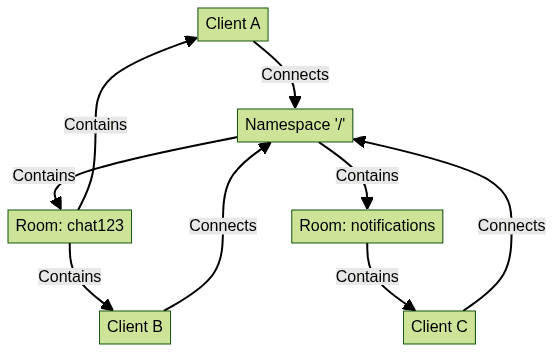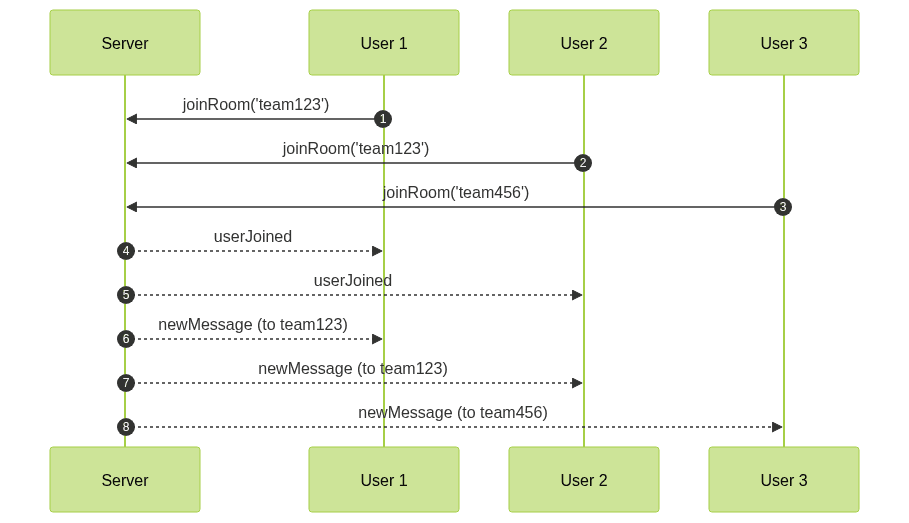Introduction to Socket.IO Rooms
Real-time applications are now essential in industries ranging from social networking to online gaming and IoT. Socket.IO, a powerful JavaScript library built on Node.js, enables developers to create robust, low-latency, bi-directional communication between clients and servers. As apps scale, organizing and managing connections efficiently becomes critical. That’s where socket.io rooms shine.
Socket.io rooms allow you to group sockets (clients) together, making it possible to send targeted messages or events without broadcasting to every connected user. This granularity is crucial for building scalable, maintainable, and efficient real-time systems. In this guide, we’ll explore everything you need to master socket.io rooms in 2025—covering architecture, code examples, advanced management, and best practices.
What are Socket.IO Rooms?
Socket.io rooms are server-side-only constructs. They allow you to assign sockets to arbitrary groups, known as "rooms," without any client-side awareness. Unlike namespaces—which segment the entire connection space into distinct endpoints—rooms are lightweight, flexible groupings that live within a namespace and can overlap.
For developers building interactive features like chat, notifications, or even integrating a
javascript video and audio calling sdk
, understanding how rooms work is fundamental to creating seamless real-time experiences.Key Differences: Rooms vs. Namespaces
- Namespaces: Logical endpoints; clients explicitly connect to them (e.g.,
/chat,/admin). - Rooms: Arbitrary groups within a namespace; used for message targeting (e.g., rooms for each chat group, project, or user session).
Use Cases for Socket.IO Rooms
- One-to-one or group chat
- Sending notifications to specific user groups
- Live collaboration features (documents, boards)
- Real-time project updates
- Private messaging
If you're building features like live video chat, integrating a
Video Calling API
with socket.io rooms can streamline targeted communication between participants.
Joining and Leaving Rooms in Socket.IO
To leverage the full power of socket.io rooms, you need to know how to add and remove sockets from rooms dynamically.
For those looking to
embed video calling sdk
features, managing room membership is essential for connecting users in private or group calls.How to Join a Room
Joining a room is straightforward using the
join() method on the socket instance.1// Server-side: User joins a room
2io.on('connection', (socket) => {
3 socket.on('joinRoom', (roomName) => {
4 socket.join(roomName);
5 // Notify others in the room
6 socket.to(roomName).emit('userJoined', socket.id);
7 });
8});
9This allows a client to be added to any room, such as a chat group or a project channel. Rooms are created on the fly if they do not exist.
How to Leave a Room
Similarly, sockets can leave rooms with the
leave() method:1// Server-side: User leaves a room
2io.on('connection', (socket) => {
3 socket.on('leaveRoom', (roomName) => {
4 socket.leave(roomName);
5 // Notify others in the room
6 socket.to(roomName).emit('userLeft', socket.id);
7 });
8});
9Practical Tips and Common Pitfalls
- Rooms are ephemeral: When the last socket leaves, the room is destroyed automatically.
- No client-side awareness: Clients do not know which rooms they are in unless you track this state yourself.
- Join/leave in event handlers: Always validate room names and permissions before allowing join/leave actions to prevent unauthorized access.
- Socket disconnects: When a socket disconnects, it leaves all rooms automatically.
If your application includes live broadcasts or events, consider integrating a
Live Streaming API SDK
to extend real-time capabilities beyond basic messaging.Broadcasting and Emitting Events in Socket.IO Rooms
Rooms make it easy to target messages to specific groups. Socket.IO offers powerful methods to broadcast or emit events to rooms, multiple rooms, or exclude certain sockets.
For React developers, combining socket.io rooms with a
react video call
solution can enable dynamic, real-time video chat experiences within your app.Broadcasting to a Room
1// Server-side: Broadcast to everyone in a room (except sender)
2io.to('roomName').emit('newMessage', {
3 user: 'Alice',
4 text: 'Hello room!'
5});
6Emitting to Multiple Rooms
1// Emit to multiple rooms at once
2io.to(["roomA", "roomB"]).emit('maintenance', {
3 notice: 'Server will reboot at midnight.'
4});
5Excluding Sockets from Broadcasts
You can exclude the sender socket from a broadcast using
socket.to(roomName):1// Exclude the sender from the broadcast
2socket.to('roomName').emit('userTyping', socket.id);
3Or, to broadcast to all except a list of sockets:
1// Advanced: Exclude multiple sockets
2ios.except([socket.id, 'anotherSocketId']).to('roomName').emit('update');
3If your use case involves integrating voice features, a
phone call api
can be paired with socket.io rooms to route audio calls to specific users or groups.Real-World Scenarios
- Notifications: Send only to relevant users
- Group chat: Broadcast messages or status updates
- Live updates: Push project changes or game state to active participants
For cross-platform projects, leveraging
flutter webrtc
with socket.io rooms can help you build real-time communication apps for both web and mobile.
Managing Socket.IO Rooms in Large Applications
As your application grows, so does the complexity of managing rooms, especially with thousands of users and dynamic use cases.
If you're developing for mobile, using a
react native video and audio calling sdk
alongside socket.io rooms can streamline group and private calls on iOS and Android.Handling Dynamic Rooms
Many applications create and destroy rooms on the fly—think temporary project collaborations, one-to-one chats, or live support sessions. Use unique, non-guessable room IDs, and consider keeping a mapping of active rooms for management.
1// Example: Creating a private room for two users
2const privateRoom = `private_${userA}_${userB}`;
3socket.join(privateRoom);
4If you're targeting Android devices, integrating
webrtc android
with socket.io rooms can help you deliver seamless real-time communication experiences.Room Cleanup and Handling Disconnections
Sockets are automatically removed from all rooms when they disconnect. However, you may need to handle additional cleanup (e.g., database updates, resource freeing) when a room becomes empty.
1// Check and clean up when a user leaves
2ios.of('/').adapter.on('delete-room', (room) => {
3 console.log(`Room ${room} deleted`);
4 // Perform custom cleanup here
5});
6Using Adapters (e.g., Redis) for Scalability
To scale socket.io rooms across multiple Node.js servers, you must use an adapter. The official
socket.io-redis adapter
synchronizes room state and events across server instances.1// Install: npm install socket.io-redis
2const { createAdapter } = require('@socket.io/redis-adapter');
3const { createClient } = require('redis');
4
5const pubClient = createClient({ url: 'redis://localhost:6379' });
6const subClient = pubClient.duplicate();
7
8io.adapter(createAdapter(pubClient, subClient));
9This enables socket.io rooms to seamlessly span multiple servers, allowing real-time apps to scale horizontally.
Socket.IO Rooms: Best Practices and Common Mistakes
Socket.io rooms are a powerful abstraction, but misuse can lead to inefficiencies or security holes. Here are some best practices for 2025:
If you want to experiment with these features in your own projects,
Try it for free
and see how socket.io rooms can power your next real-time app.Tips for Efficient Room Management
- Use meaningful, unpredictable room names for privacy and security
- Limit room size if necessary (e.g., for video conferences)
- Track room membership in your application state if needed
- Leverage adapters for scaling across servers
- Clean up resources when rooms are no longer needed
Common Errors and How to Avoid Them
- Not validating access: Always check that a user is authorized to join/leave a room
- Leaking memory: Forgetting to clean up after dynamic rooms
- Assuming client-side awareness: Remember, only the server knows room membership
- Neglecting multi-server setups: Use the Redis adapter if you plan to scale
Conclusion: Leveraging Socket.IO Rooms for Scalable Real-Time Apps
Socket.io rooms provide a flexible foundation for building scalable, efficient, and maintainable real-time applications. Whether you’re implementing chat, notifications, or collaborative tools, mastering room management is key to success. Embrace best practices, use adapters for scaling, and experiment with advanced use cases to unlock the full potential of socket.io rooms in your Node.js apps in 2025.
Want to level-up your learning? Subscribe now
Subscribe to our newsletter for more tech based insights
FAQ